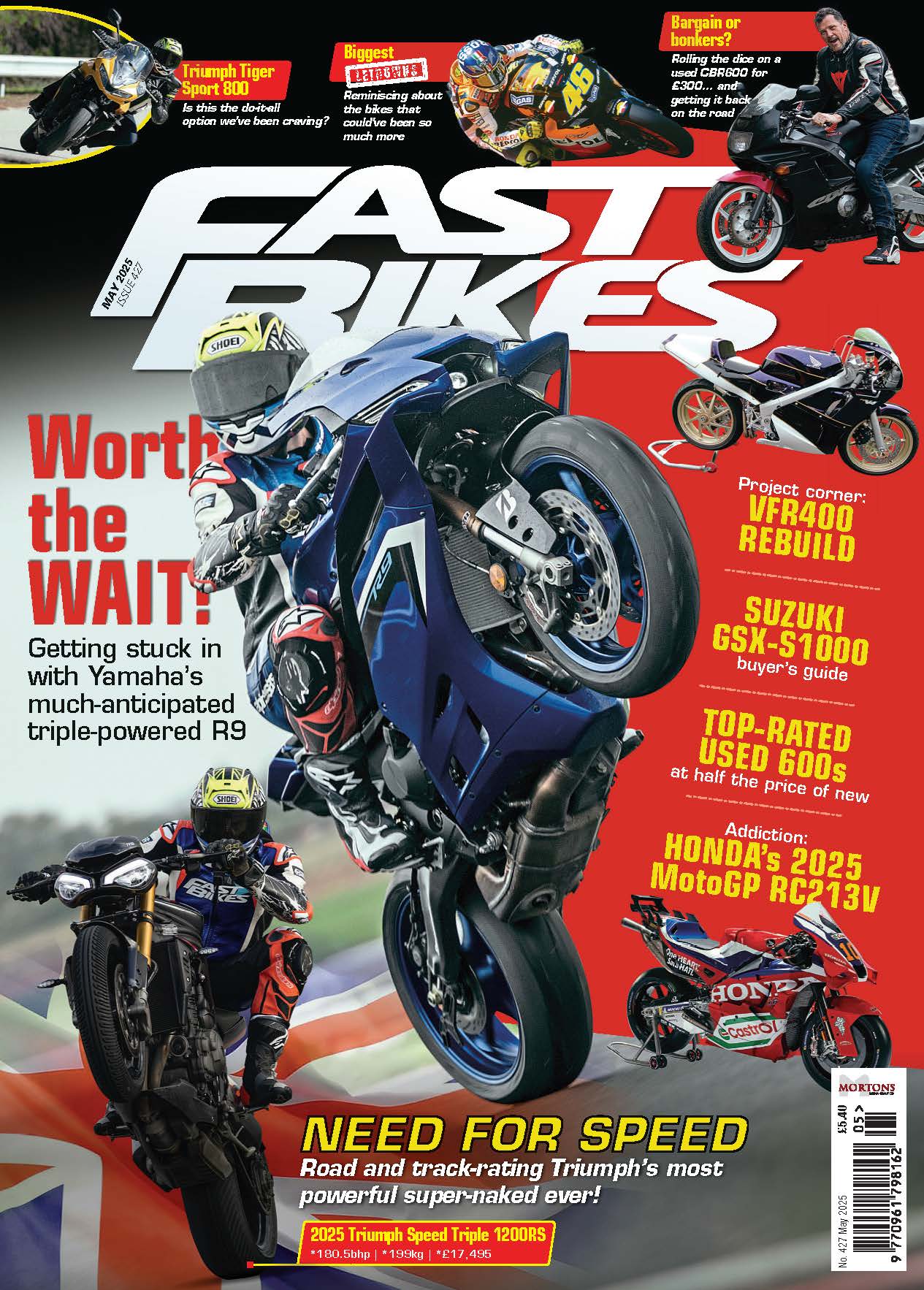Fast Bikes crowned the Ducati Panigale V4 SP the ultimate sportsbike of 2021. But how do you improve on perfection?
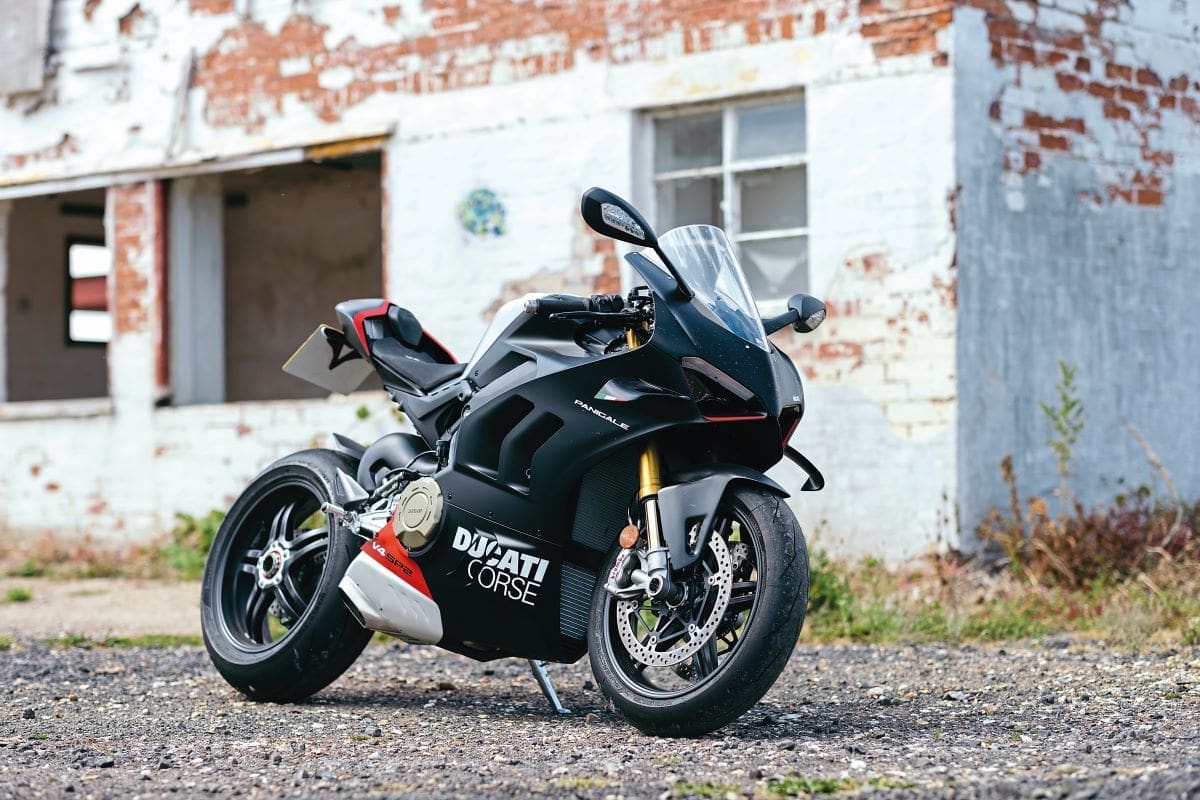
Words> Johnny Mac
The SP formula is a proven one for Ducati in the shape of the Panigale and Streetfighter. The addition of carbon wheels in particular gives the donor bike a new dynamic, and some bling components further extend the performance envelope, give it exclusivity and desirability over the base models. In each case there is no denying that the SP badge is much more than just a few trinkets and a bit of faux carbon, and that the current bearers of the badge are worthy of it. Once upon a time, before Ducati had R models as its homologation specials, it had SPs up to and including the 916 SP as the homologation specials. The 996 carried the SPS derivative but was also the first Ducati model to bear the R badge to mark it out as the one that went racing. Then the SP badge got wheeled out once again, but only on the Hypermotard, which, if I’m being honest, should only really have qualified for the S badge to identify it as a step up in spec from the base model. For those of us of a certain age who can remember the 888 and 916 SPs, it was a little bit nauseating to see the SP badge used on such a bike.
Fast-forward to the present(ish) day, and with the 1000cc homologation special Panigale R carrying on the status as the bike that goes racing, when Ducati announced it was bringing back the SP badge, I did worry that we were going to get another Hypermotard – something not really worthy of the status. I needn’t have worried…
Just over a year ago we declared the Ducati Panigale V4 SP our Ultimate Sportsbike for 2021, the king of kings. We were unanimous, and the decision to crown it the best of the best was frankly easy due to the V4 SP being literally better at everything than all the others. Easiest to ride on the road, fastest on track, fastest at the drag strip, the best technology, best comfort, and best engine. It was pretty much a clean sweep in all the metrics we thought of that mattered. We got some stick for not factoring price into the discussions so brought the V4 SP back to go up against an Aprilia RS660 at a third of its price, and it even won that comparison, too.


It’s hard to believe, but at just over £30,000, the V4 SP was a bargain. I do believe that we could put a V4 SP up against any bike in any context, and it would probably come out on top, unless it was a test that involved taking a pillion; it would fail that spectacularly. There isn’t a bike I can think of that can hold a candle to the V4 SP… until now. Say hello to the Panigale V4 SP2.
As I have mused elsewhere in this issue, in the absence of anything significant from any of the other manufacturers to change the world order, it has fallen to Ducati to produce something better than the V4 SP – something it didn’t have to try too hard to do in the case of the SP2 given the overhaul the 2022 Panigale V4 received.
To understand the differences between the V4 SP and the V4 SP2, you need to know what the differences are between the 2021 Panigale V4 and the 2022 Panigale V4; all the SP specific bling has been carried over from the SP to the SP2. That means the carbon wheels, Brembo Stylema R brakes, STM clutch, carbon wings and mudguard and snazzy rearsets are identical on the SP2 and SP – although the profile of the wings is different on the SP2 with less drag, but still the same pointless claim of 37kg of downforce at 186mph. One useful purpose the new profile wings does serve is along, with the extra cooling slots in the belly pan, they identify the SP2 as a 2022 spec Panigale for all the anoraks like me out there at a glance. It’s a shame that it falls to such subtleties to tell the 2022 bike apart from the 2021 bike because there are in fact a lot of significant differences between the two – some small and subtle, some more obvious – that all come together to make a dramatic and, in truth, unexpected difference.
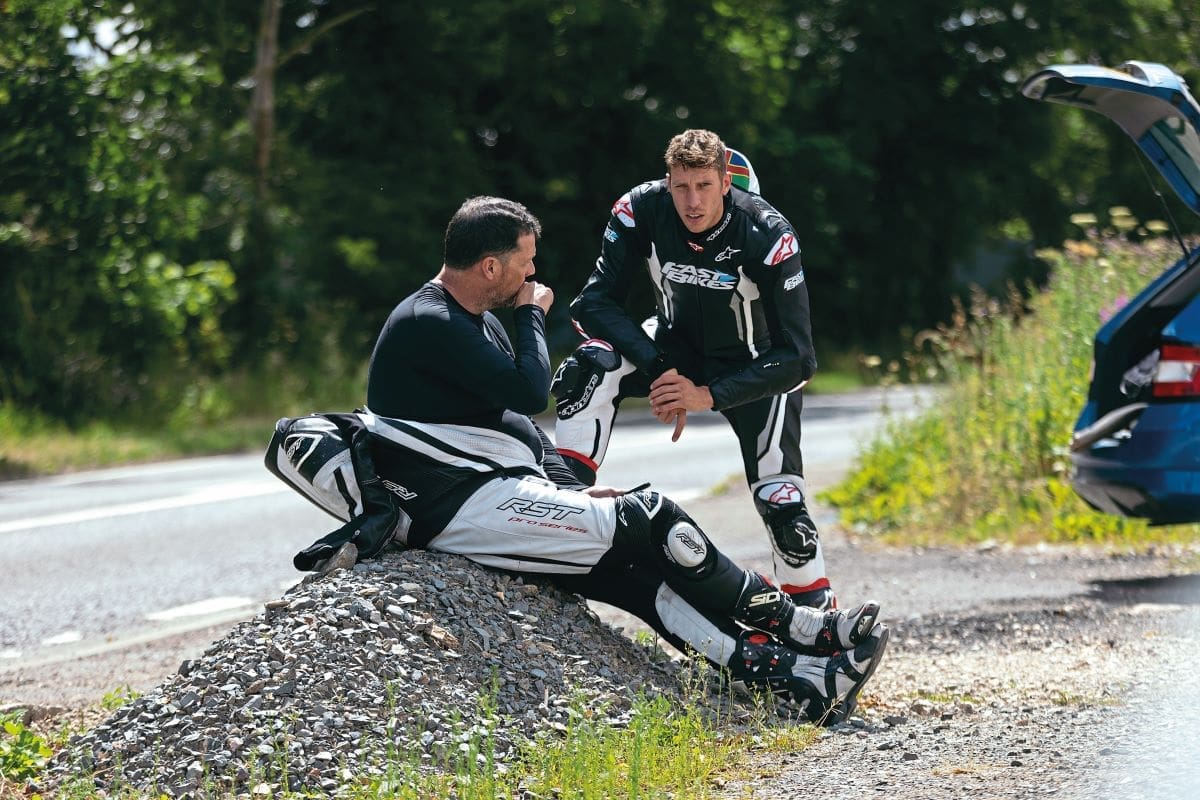
It’s at this point I should go on record as finding myself feeling very conflicted about the upgrades to the 2022 Panigale V4. They are mind-blowing from a technical and engineering point of view because most of them are digital; certainly the ones that make the most noticeable difference to how the bike feels on the road. I’ve been around long enough to know that this is where we are nowadays when a bike can be transformed with a new set of ‘maps’ for fuelling, ignition timing, engine braking, and even the quickshifter action. I’m conflicted because on one hand I’m in awe at the sheer technical voodoo that is a modern bike’s electronic systems, but on the other I’m a bit sad that I can’t point to anything on the bike to bore my mates with how and why it makes it better. Call me old-fashioned (I am), but saying “Yeah, it’s got a load of new maps” doesn’t have the same ring to it as “See that exhaust? That’s made from titanium.” The bulk of the upgrades to the 2022 Panigale are about as sexy as a software upgrade to my phone, but there’s absolutely no denying that they work. It’s not just 1s and 0s that are different, though; there are other things that I understand are different, but before I get into them, it is worth mentioning what the digital stuff is first, given that it forms such a big part of the difference between the ‘21 and ‘22 bike.
At the heart of the upgrade is a first for any production bike, with the Panigale getting bespoke power maps for each gear. So, for three of the four power modes that are all available in each of the four rider modes, power is restricted in the first three gears, which themselves are taller, further adding to the sting being taken out of the power in the lower gears. The fourth power mode gives you full power in all six gears, which is what the 2021 bike has in all modes.

This is extremely detailed programming and the sort of bespoke mapping you find in trick race bikes, which tells you all you need to know about how the ‘less is more’ approach is used by people who are trying to break lap records.
Don’t for one moment think that the 2022 Panigale V4 is a docile pussycat in the first three gears, it really isn’t. It’s terrifyingly fast, but the slightly softer, smoother power delivery, combined with the counter rotating crankshaft and 5mm higher swingarm pivot position, just seems to let you get more power out earlier and for longer before the new, smoother anti-wheelie has to wake up, the net effect being… you actually go faster for longer before the bike starts to get into a fight with itself. In fact, I’d go as far to say that during the couple of days we were out on the bikes, and despite my very best efforts, I don’t recall mine getting into cut/release/cut/release cycle of electronic intervention.
It’s got the latest NPX 25/30 Öhlins semi-active pressurised forks which have slightly lighter springs (9.5Nm V’s 10Nm), a touch more preload and 5mm longer travel, which might not sound like a lot, but it is massive. It’s the sort of set-up change you would make to a race bike if you were racing at two tracks with different characteristics. The heavier spring/shorter stroke set-up on the ‘21 bike would be the kind you might use on a smooth track with a lot of long, heavy braking zones – like Donington Park, for example. The set-up with the lighter springs and longer stroke would be more suited to bumpier surfaces and longer corners where the bike spends long periods on the edge of the tyre, somewhere like Thruxton. It’s more evidence of Ducati just softening off the Panigale to make it more usable, hence nicer to ride and faster.


The combination of this, plus a slightly longer stroke on the rear shock too, and the higher swingarm position, is aimed at sticking the Panigale down to the ground better under cornering loads and under acceleration, which is virtually impossible to tell on the road, but I can’t deny that the SP2 does have a different feel to it on the road. The best way I can describe it is like a factory race bike. It feels like it’s been hand-built, with every component in the suspension machined, matched, and assembled perfectly, then set up just for you. Every movement of the suspension at each end of the bike is smooth and perfectly controlled. I’ve been on bikes with extremely high quality suspension, typically race bikes with prototype forks and shocks valued at twice the price of the whole of the SP2. Those sort of set-ups aren’t just nice to experience, they are a privilege, and the SP2 falls into that category, such is the quality of its ride… and I haven’t even got to the star of the show.
The gearbox and quickshifter set-up is simply ridiculous with how smooth and seamless each gear change is. As far as I’m aware, apart from the changes to the ratios of the first three (and sixth) gears, there aren’t any mechanical changes to the gearbox. This must mean, by a process of elimination, that the difference is to the quickshifter/blipper maps and the new sensor.
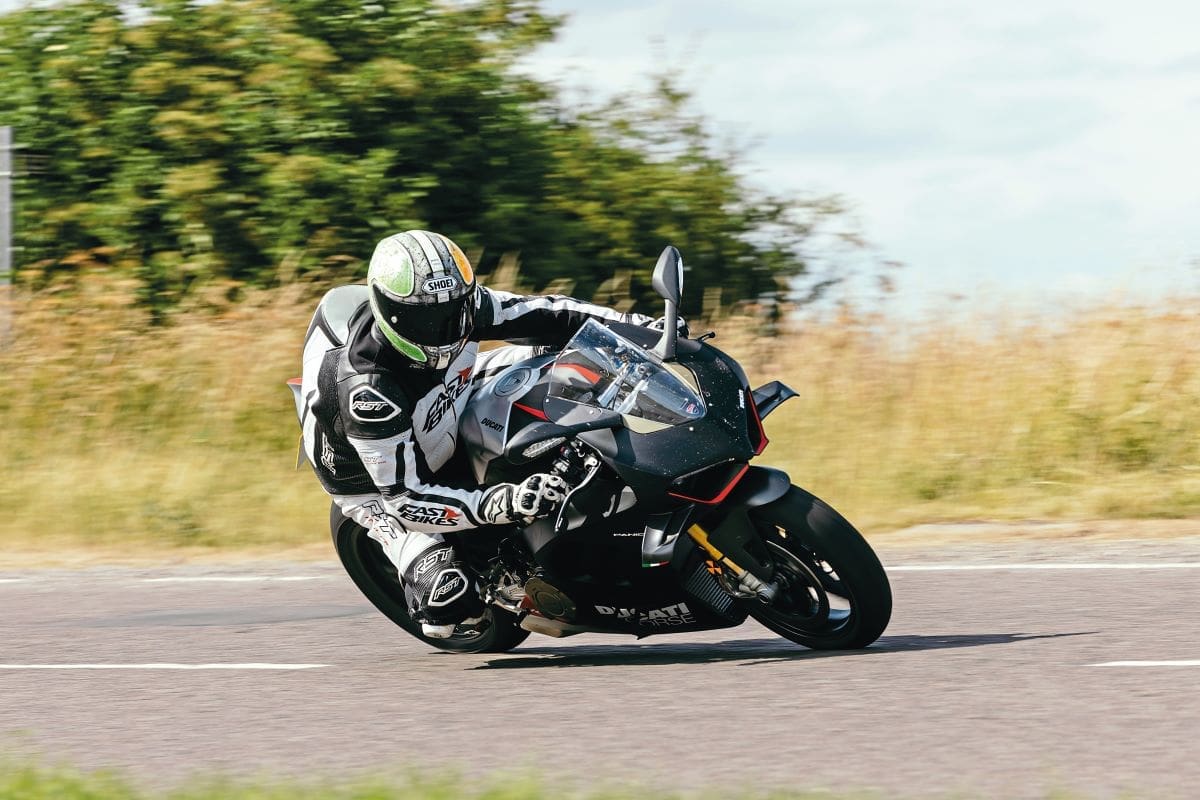
Never since riding a £160,000 Honda RC213V-S have I used a gearbox so perfect in how it swaps cogs. The giveaway is when you’re dawdling at low speed, low revs, and less than 50% throttle, and still it swaps gears up and down so smoothly and so quickly; the only clue that anything has happened is a change in the engine’s note.
It makes me imagine that the gearbox internals must look like the inside of an expensive Swiss watch, such is the precision and consistency. I never thought I’d ride a bike with a gearbox as good as the RCV’s ever again, but now I have. Thank you, Ducati.
There is a taller, narrower fuel tank that carries a litre more. The new profile is supposed to make life easier physically for a rider on track to hold on with less effort, but I don’t know about that. That said, given the level of detail Ducati has gone to elsewhere to make the Panigale better by making it easier, I wouldn’t be surprised if it really did let the rider tuck in that bit lower, or hold on with less effort when at full lean. I’m very happy to give Ducati the benefit of doubt on this one.
We are living in truly interesting times and entering an era when a bike can be transformed via electronic maps alone, and that is essentially what Ducati has done here. It could have left the rest of the Panigale V4 as was and it would still have been a significant improvement. But hats off to Ducati –it went through the bike from front to back, not only upgrading the suspension but also changing its set-up and tweaking the geometry. Then, having done that, Ducati hit it with all the SP goodies to give it the different dynamic that the SP has compared to the S. Bravo for doing the seemingly impossible and making a bike better than the V4 SP.
Engine
Ducati has rinsed a whopping 1.5hp peak power out of the glorious twin-pulse 1103cc V4 engine with its counter rotating crankshaft, and an extra 2.5hp at 13,000rpm while still hugging trees in its spare time. There’s a new oil pump and circuit to reduce drag and bigger tailpipe on the exhaust to reduce back pressure. It now makes a frankly academic 215.5bhp. The gear box gets a longer first, second, third and sixth gear to take the sting out of the acceleration and a fractionally higher top speed.
Electronics
The 2022 electronics are hardcore, and at the sort of level you get on race bikes that bother lap records by having bespoke fuel and ignition maps per gear. There are four road riding modes and four track riding modes, plus a new ‘Full’ power mode that delivers full power in all gears if you really need it (you won’t). New quickshifter sensor and software maps result in the best gearbox/shifter combination this side of a MotoGP bike. The SP2 gets GPS datalogger and lap timer as standard. These are the gold-standard electronics by which all others are compared to.
Chassis
New suspension settings and swingarm pivot position, softer fork springs, longer travel front and rear, and the latest gas NPX25/30 pressurised forks from Öhlins, all electronically controlled semi-actively or can be ‘fixed’ to behave like normal analogue suspension but still adjusted via the switch gear. If there is a better suspension set-up on any bike, we have yet to ride it.
Bodywork
Subtle changes to the fairings feature new vents in the bellypan to aid the cooling of the engine and oil radiator, which will help the SBK teams. The seat is flatter to help with moving the bike around. The fuel tank has been sculpted to allow the rider to tuck in lower and hang on easier at full lean, and it also gains an extra litre of capacity.
SP badge
SP status means you get carbon wheels that are 1.4kg lighter than alloy ones and reduce inertia by up to 46%, and Brembo Stylema R brakes from the Superleggera and an adjustable MCS master cylinder. There’s also a posh STM-Evo dry clutch, snazzy ultra-grippy rearsets, a narrow 520 chain to reduce inertia in the drive train, debatable paint job, carbon mudguard, and, yes, the pointless wings, as well as a new low-drag profile, also made from carbon instead of plastic.

I’ve got two problems with the SP2; well, three if you count the fact that the bike deserves so much more than a matte black paint job. Much as it deserves to be the poster bike of a generation, it’s never going to manage it with a boring colour scheme. The red accents here and there are nice, but come on, Ducati, it’s a D-minus for effort here.
My first big problem with the SP2 is that it makes me look and feel like a fool in more ways than one. Obviously, its performance envelope is so far beyond anything I’m capable of – or anyone outside of world championship racing for that matter – that it could leave me feeling a tad inadequate. But it doesn’t achieve this by virtue of it being so accommodating to my pathetic levels of talent – no, it’s not that which upsets me about it.
I caught myself on more than one occasion looking at the red line on the rev counter set at 15,500rpm wondering just what it would be like to rev it that high and knowing in the pit of my stomach that on the road it is impossible. I remember 17 years ago when I got to ride a GSX-R1000 K5 press bike for the first time and the ‘thing’ in the office at the time was how it was so fast that it was impossible to rev it out in third gear on the road. Today, on the SP2, that’s impossible in first gear.

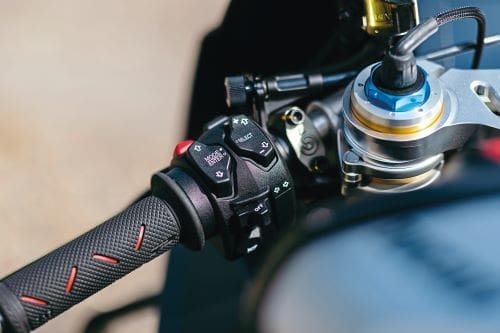
Of course, there are plenty of people who will say that this makes the Panigale pointless, but I will always disagree with them on the grounds that if going flat-out in every gear is your only prerequisite to a bike being relevant or not, then you’re missing the whole point of motorcycles – plus, you probably need a faster bike. It’s the package that matters and how it makes you feel, how it turns, how it talks to you, how it intimidates you, how it helps you, how it challenges you, and, crucially, if it makes you smile. The SP2 does all these things… and some through being so competent yet so easy.
My last and biggest problem with the SP2 is just how it shines a light on the updated Fireblade for being well… not really updated. If there was ever a bike screaming for a rethink and being made easier to ride, it’s the Fireblade, which got a different rear sprocket… and that makes me feel sad for an opportunity missed. Compare and contrast to the effort Ducati has gone to with the Panigale, a bike that literally nobody ever suggested needed an update, Honda has really come up short, not least because the only bike that kept coming to my mind as the closest thing to the Ducati SP2 is a Honda. It’s just sad that it’s the unobtanium RCV213V-S and not the Fireblade.
The RCV feels the same as the SP2, and has the same, beautifully smooth and refined feel to every part that you come into contact with, from the throttle to the gear shift and everything in between. Ironically, and only because of the era it was conceived in, the RCV is pretty basic next to the SP2 by virtue of not having a blipper, no adjustability to the electronics, no anti-wheelie, no slide control, and so on.
Ducati absolutely didn’t need to update the Panigale, but it did – in a big way. The brand has delved right down to individual fuel and ignition maps per gear, it’s changed three of the ratios in the gearbox, replaced the suspension, moved the swingarm position, changed the fuel tank, exhausts and oil pump, and got more power out of it when it really didn’t need any of those things doing.
This makes me feel like a bit of a fool when I declared last year that the V4 SP was perfect and it turns out it wasn’t… because it’s now been made much better.
Thanks a million, Ducati.

TECH DATA:
2022 Ducati Panigale V4 SP2
ENGINE
Type: 1103cc V4 four-stroke, counter rotating crankshaft, desmodromic valve timing
Bore x stroke: 81mm x 53.5mm1 x 53.5 mm
Fuelling: EFI
Claimed power: 215.5bhp @ 13,000rpm
Claimed torque: 123.6Nm @ 9500rpm
ELECTRONICS
Riding modes: Yes
Traction control: Yes
ABS: Yes
Quickshifter: Yes
Autoblipper: Yes
Wheelie control: Yes
Launch control: Yes
CHASSIS:
Frame: Alloy front frameloy front frame
Front suspension: Öhlins NPX25/30 pressurised 43mm fully adjustable Öhlins Smart EC2.0 semi-active.
Rear suspension: Öhlins TTX36 Öhlins Smart EC2.0 fully adjustable
Front brakes: 2x 330mm discs, Brembo Stylema R four-piston calipers
Rear brake: 245mm disc, twin-piston Brembo caliper
DIMENSIONS
Wheelbase: 1469mm
Seat height: 850mm
Wet weight: 194Kg
Fuel capacity: 17 lts
INFO
Price: £34,295
From: www.ducati.com

